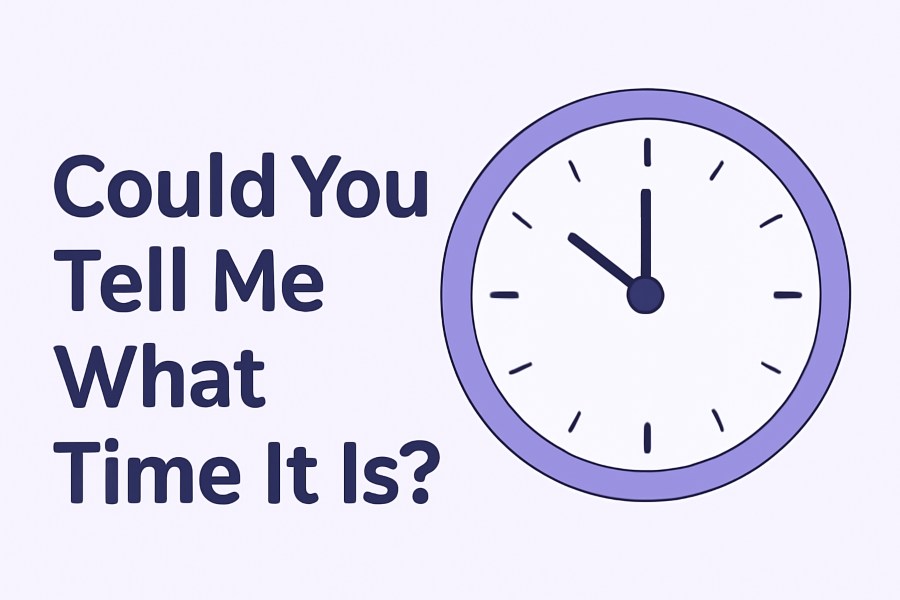Could You Tell Me What Time It Is?
"Could you tell me what time it is?" is one of the most commonly asked questions worldwide. In our fast-paced, schedule-driven society, knowing the exact time is essential for coordinating activities, meetings, and daily routines.
The current time is displayed above, showing hours, minutes, and seconds in your local time zone. This time is determined by your device's system clock, which typically synchronizes with internet time servers to maintain accuracy.
Modern Ways to Tell Time
In today's digital world, there are numerous ways to check the current time:
Digital Devices
Most people check the time using digital devices such as:
- Smartphones: The most common way to check time today, always within reach and automatically synchronized.
- Computers: Display time in the taskbar (Windows) or menu bar (Mac).
- Smart watches: Combine traditional wristwatches with digital accuracy and additional features.
- Smart home devices: Voice assistants like Alexa, Google Assistant, or Siri can tell you the time when asked.
Traditional Methods
Despite the digital revolution, traditional timekeeping methods remain popular:
- Analog watches: Classic timepieces that display time using hour, minute, and sometimes second hands.
- Wall clocks: Common in homes, offices, and public spaces.
- Public clocks: Found in town squares, church towers, and transportation hubs.
- Radio: Many radio stations announce the time regularly, especially during news broadcasts.
Online Time Services
The internet provides access to highly accurate time sources:
- Time.is: Displays precise time for any location worldwide.
- World Clock: Shows current time across different time zones.
- Time.gov: Official U.S. time from the National Institute of Standards and Technology (NIST).
- Google: Simply searching "what time is it" will display your local time.
How Accurate Is the Time You See?
The accuracy of displayed time varies depending on the source:
Atomic Time
The most accurate timekeeping method uses atomic clocks, which measure time based on the resonance frequency of atoms (typically cesium-133). These clocks are accurate to within one second over millions of years and form the basis for Coordinated Universal Time (UTC), the global time standard.
Network Time Protocol (NTP)
Most digital devices synchronize their time using NTP, which connects to time servers that ultimately trace back to atomic clocks. This typically provides accuracy within milliseconds, though network delays can occasionally affect precision.
Device Clock Accuracy
Between synchronizations, your device relies on its internal clock, which may drift slightly. Factors affecting accuracy include:
- Quality of the device's oscillator
- Temperature variations
- Battery level (in portable devices)
- Time since last synchronization
Most modern devices automatically synchronize regularly to maintain accuracy within a second or two of the actual time.
Understanding Time Zones
When someone asks "what time is it?", the answer depends on their location. The Earth is divided into 24 primary time zones, each approximately 15 degrees of longitude wide (though political boundaries often modify these).
Major Time Zones
Here's the current time in several major time zones around the world:
Time zones are typically expressed as offsets from UTC (Coordinated Universal Time). For example, Eastern Standard Time (EST) is UTC-5, meaning it's 5 hours behind UTC.
Daylight Saving Time
Many regions observe Daylight Saving Time (DST), moving clocks forward by one hour in spring and back in autumn. This practice aims to make better use of daylight during summer months but creates temporary shifts in time zone relationships.
The Importance of Knowing the Time
Asking "could you tell me what time it is?" reflects our fundamental need to synchronize our activities with others and organize our days efficiently. Time awareness helps us:
- Arrive punctually for appointments and meetings
- Coordinate with people across different time zones
- Plan our daily schedules effectively
- Catch transportation on time
- Maintain social etiquette by respecting others' time
In our increasingly connected global society, understanding not just local time but time differences across regions has become essential for both business and personal interactions.
The next time someone asks you "could you tell me what time it is?", you'll not only be able to provide the current time but also appreciate the complex systems and technologies that allow us to measure time with remarkable precision.
